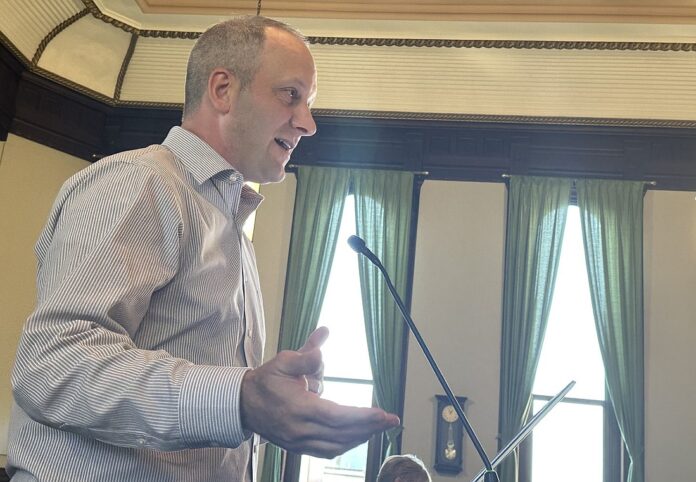
The U.S. 30 East study is nearly halfway complete, and on Tuesday the Kosciusko County Commissioners received an update on how the study is progressing.
Rusty Holt, supervising traffic engineer with engineering firm WSP that was hired by the Indiana Department of Transportation for the ProPEL U.S. 30 East study, reminded the commissioners that the study includes Kosciusko, Whitley and Allen counties.
“We’re looking at this section specifically to see what the needs are in these communities, but we are in constant communication with the other three studies, especially U.S. 30 West, to make sure that our corridor as a whole makes sense, all of U.S. 30,” Holt said.
The other two studies are for U.S. 31 North and South.
“As a reminder, it is a two-year planning study. We’re about halfway through. And it is a 20-year study, so we’re looking at the needs for the next 20 years, helping INDOT identify what the roadway should look like in the future,” he stated.
So far, Holt said their efforts have focused on the “why” – why are potential improvements on the roadway being evaluated and why are those improvements important to the community.
There have been public meetings, community office hours, booths at community events and other activities to collect as much public input as possible.
“Part of why we’re here today is a desire to partner with you all as community leaders to help us see what this next 20 years should look like,” Holt said.
To date, 37% of the public comments have been about safety along the corridor, he said, with another 36% about access to the corridor and 25% about mobility along the corridor.
“So, using that public input, we paired it with transportation data – traffic volumes and crashes – to come up with purposes,” Holt said. “So the next step is the Purpose & Need, so identifying transportation needs, and then the desired outcomes, or the purposes.”
Six needs have been identified, with the first being safety. “There have been more than 2,700 crashes just in our section – the three-county section – in the past five years, which is a high number. A lot of intersections have a higher-than-average frequency or severity of crashes, so our desired outcome is to improve roadway safety by identifying solutions that can reduce the number and severity of crashes along the corridor and at specific locations,” he stated.
The second need is that crashes aren’t just a safety problem, they’re also an efficiency problem, Holt said. “Based on those crash statistics, there’s a 73% likelihood that there’s a crash somewhere along the corridor on any given day, which affects the reliability of the roadway – you don’t know how long it’s going to take you to get from one point to another.”
He said one of their desired outcomes is to improve safety, which will benefit efficiency and mobility of the roadway.
Thirdly, he said, they’ve heard a lot about speed along U.S. 30. Reviewing publicly available data, Holt said, “Over the past year, we find that the average speeds are actually below the posted speed limit, which is usually surprising because when you drive it, people are going faster than the speed limit. But the average is lower because of traffic signals and other congestion that you might have that disrupt the traffic flow, so it counteracts the people that are speeding.”
He said the desired outcome is that people traveling below the posted speed limit get closer to the posted speed limit and those who are driving faster than the speed limit drive more safely and closer to the posted speed limit.
The fourth need he referred to was access points. There are 189 different access points, which include public roadways, driveways and field entrances.
“Each of those are disruption points to the traffic flow, causing safety concerns or operational concerns,” Holt said. “So our desired outcome here is to find ways that we can eliminate or consolidate access points, so we can reduce the number and provide a better overall experience.”
On the fifth need, Holt said that’s operations. “So we have 12 intersections that have failure operations. Those failing operations are traffic that is either trying to get across U.S. 30, to turn onto U.S. 30 or turn off U.S. 30. U.S. 30 itself actually operates fairly well as people try to drive through the corridor, but access to and from the corridor is a failing operation,” he said.
The desired outcome is to find solutions that will improve local mobility.
The sixth and final need Holt pointed out was the regional use of the roadway. He said they know it’s an important roadway to get people through and to the area.
“About one-third of the traffic out there are trucks. We expect that to grow into the future – not the percentage but the amount of trucks to grow – as the local economy develops and grows. There will be an additional need for freight and U.S. 30 will be the primary route for that,” he said.
The desired outcome here is to maintain or improve regional mobility.
“So, based on those six purposes, we’ve narrowed it down to three roadway needs, or transportation needs, that we need to address as we move forward with the study,” Holt said.
Those three needs are roadway safety in the corridor for all users, mobility for local users and enhancing efficiency and reliability of U.S. 30 as a regional and statewide corridor, he stated.
“So those are the three need points that we’ll be looking for as we move forward into the alternatives analysis, which is what’s next,” Holt continued.
They will begin to look at what kind of solutions there are to address the needs, beginning with every possible solution that they have.
“We have more than 50 different solutions that we’re currently looking at, and we’re going to look at those solutions and see how they address those three needs that I mentioned. Anything that addresses a need will move forward into further study and consideration. Things that don’t address the needs will be discarded and we won’t continue looking at those,” Holt said.
The solution alternatives will be published to the ProPELUS30.com website, have a comment period, and then anything that passes the first level of screening will move on to the second level of screening.
“That second level of screening will look at those alternatives next to each other, look at deeper and a more detailed look at costs, at benefits, at impacts and see which ones of those are best for the needs of the corridor itself. So, which alternatives suit the needs better than other ones, and the ones that meet them the best will pass over to the third level of screening, and the ones that don’t will fall out of the screening process,” Holt explained.
In the third level of screening, a more detailed look will be taken at each alternative. There will be a drawing of what it could look like, with specific costs, environmental impacts, roadway impacts and how it impacts the community itself.
That will end with just a handful of potential solutions that will be taken into a cost study.
Holt said there’s about a year left of the study. The universal alternatives are being worked on now and are planned to be published to the website this fall, hopefully in September, followed by a 30-day comment period.
“We’ll be working on the level two screening. That should be published to our website and available for public comment this winter. And then, finally, level three screening will be in the spring of 2024, so we’ll publish that to our website but also have public information meetings at that point so we can get as much public feedback as possible then since that’s the most detail we’ll have,” Holt said.
All of that will then be moved into the final part of the study, which will be published and then there will be more public meetings and the study will be concluded in fall/winter 2024.
Commissioner Cary Groninger thanked WSP for all the work they’ve done on the study.
“I know there’s been lots of public meetings and business hours at libraries and local communities and different things to try to get as much public input on this. I know when you really start to put lines on maps or alternatives on how to improve these intersections, it’s going to definitely bring more people out who want to see what those ideas might be,” Groninger said.
When one looks at the number of accidents – 2,717 over the last four years, he said, that figures out to nine crashes per mile per year for the entire length of the study area.
“Safety is really big. Something we need to look at, but I think we can’t lose sight of just how big of an economic driver this is for our community. This is really a lifeline for our community, as far as how we interact with our neighboring communities, so from an economic perspective it’s really important,” Groninger stated.
He said it was really important for the public to be a part of the process.
Warsaw Mayor Joe Thallemer, who chairs the U.S. 30 Coalition, said he appreciated the update and there was still a lot of work to do.
Commissioner Bob Conley asked Holt if he had that list of 50 solutions. Holt said that’s not been published yet, but it ranges from something simple for one intersection all the way to a full freeway. He said they’re looking at pretty much anything that could solve the problems.



